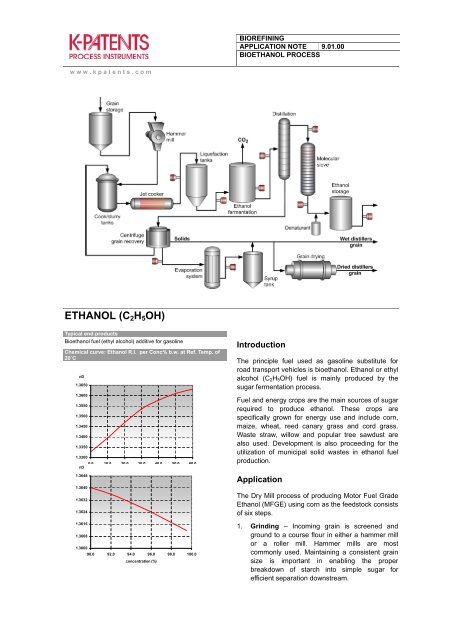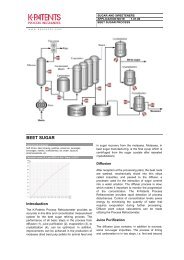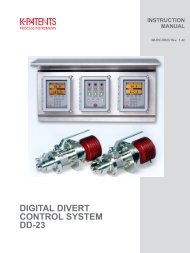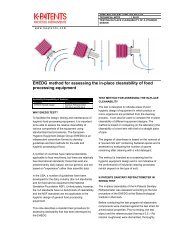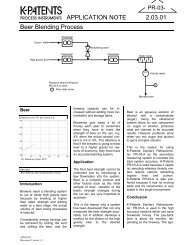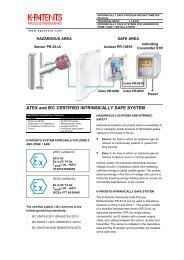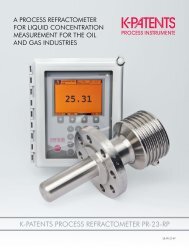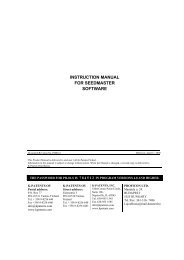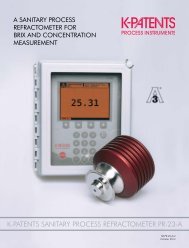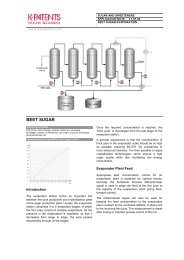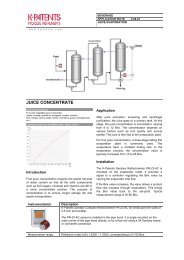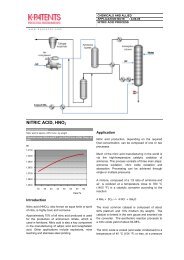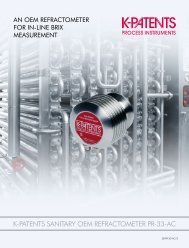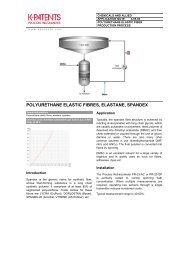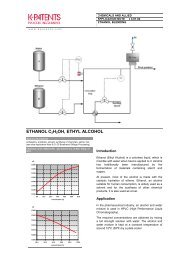ETHANOL (C2H5OH) - K-Patents
ETHANOL (C2H5OH) - K-Patents
ETHANOL (C2H5OH) - K-Patents
You also want an ePaper? Increase the reach of your titles
YUMPU automatically turns print PDFs into web optimized ePapers that Google loves.
BIOREFINING<br />
APPLICATION NOTE 9.01.00<br />
BIO<strong>ETHANOL</strong> PROCESS<br />
www.kpatents.com<br />
<strong>ETHANOL</strong> (C 2 H 5 OH)<br />
Typical end products<br />
Bioethanol fuel (ethyl alcohol) additive for gasoline<br />
Chemical curve: Ethanol R.I. per Conc% b.w. at Ref. Temp. of<br />
20˚C<br />
nD<br />
1.3650<br />
1.3600<br />
1.3550<br />
1.3500<br />
1.3450<br />
1.3400<br />
1.3350<br />
1.3300<br />
0.0 10.0 20.0 30.0 40.0 50.0 60.0<br />
nD<br />
concentration (%)<br />
1.3648<br />
1.3640<br />
1.3632<br />
1.3624<br />
1.3616<br />
1.3608<br />
1.3600<br />
90.0 92.0 94.0 96.0 98.0 100.0<br />
concentration (%)<br />
Introduction<br />
The principle fuel used as gasoline substitute for<br />
road transport vehicles is bioethanol. Ethanol or ethyl<br />
alcohol (C 2 H 5 OH) fuel is mainly produced by the<br />
sugar fermentation process.<br />
Fuel and energy crops are the main sources of sugar<br />
required to produce ethanol. These crops are<br />
specifically grown for energy use and include corn,<br />
maize, wheat, reed canary grass and cord grass.<br />
Waste straw, willow and popular tree sawdust are<br />
also used. Development is also proceeding for the<br />
utilization of municipal solid wastes in ethanol fuel<br />
production.<br />
Application<br />
The Dry Mill process of producing Motor Fuel Grade<br />
Ethanol (MFGE) using corn as the feedstock consists<br />
of six steps.<br />
1. Grinding – Incoming grain is screened and<br />
ground to a course flour in either a hammer mill<br />
or a roller mill. Hammer mills are most<br />
commonly used. Maintaining a consistent grain<br />
size is important in enabling the proper<br />
breakdown of starch into simple sugar for<br />
efficient separation downstream.
BIOREFINING<br />
APPLICATION NOTE 9.01.00<br />
BIO<strong>ETHANOL</strong> PROCESS<br />
www.kpatents.com<br />
2. Cooking – The ground flour is mixed with water<br />
and enzymes. The temperature and the<br />
pressure are raised to 120°C (248°F) and 1-3 br<br />
(10-40 psig) for partial sterilization. The mixture<br />
temperature is then kept elevated at 85-90°C<br />
(185-194°F) for 2-4 hours so the enzymes break<br />
the starch down into simple sugar. The resulting<br />
product is called “mash.”<br />
3. Fermentation – The mash is added to the<br />
fermentation tanks, along with large amounts of<br />
yeast. The yeast converts the sugar into ethanol,<br />
CO 2 and heat. This step can take between 40-70<br />
hours. The resulting product is called “beer”.<br />
4. Distillation – The beer is then distilled by the<br />
application of heat to boil off the ethanol and<br />
separate it from the non-fermentable content.<br />
5. Dehydration – Distillation produces ethanol,<br />
which contains 5% water (190 proof). The water<br />
is then removed by passing the fermented<br />
solution through columns packed with molecular<br />
sieves to produce the 100% (200 Proof) ethanol.<br />
6. Non-fermentables – The non-fermentable<br />
components are separated after distillation using<br />
a centrifuge. After the centrifuge, the solids can<br />
be sold as wet distiller grains or dried to produce<br />
dried distiller grains. The remaining liquid called<br />
thin stillage is recycled back to the slurry tanks.<br />
Installation<br />
The K-<strong>Patents</strong> Refractometer PR-23-GP/AC can be<br />
installed directly into the main line or in a by-pass.<br />
The K-<strong>Patents</strong> refractometer gives an instant<br />
indication of concentration levels with excellent<br />
repeatability. A prism wash system is not required.<br />
Instrumentation<br />
Description<br />
K-<strong>Patents</strong> Sanitary Compact Refractometer PR-23-AC for small pipe line sizes of 2.5<br />
inch and smaller.<br />
The PR-23-AC sensor is installed in the pipe bend. It is angle mounted on the outer<br />
corner of the pipe bend directly, or by a flow cell using a 3A Sanitary clamp or<br />
Varivent® connection.<br />
K-<strong>Patents</strong> Process Refractometer PR-23-GP is an industrial refractometer for large<br />
pipe sizes and tanks, cookers, crystallizers and kettles. Installation through a flange<br />
or clamp connection.<br />
Measurement range:<br />
Refractive Index (nD) 1.3200 – 1.5300, corresponding to 0-100 % by weight.


